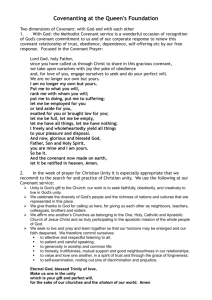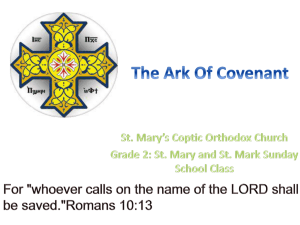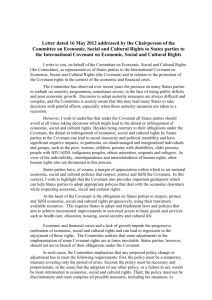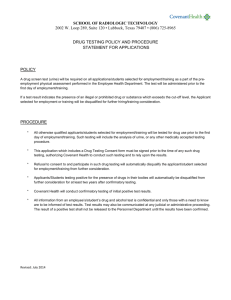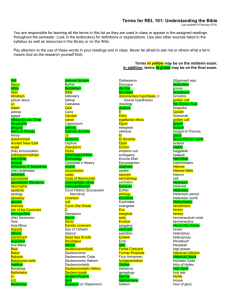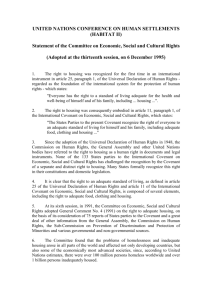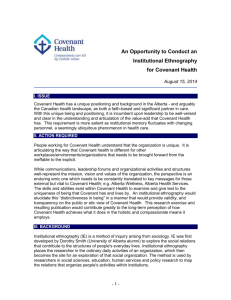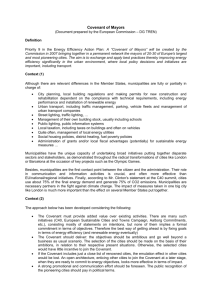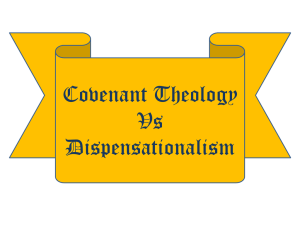Classroom Management: A Covenant Approach
advertisement
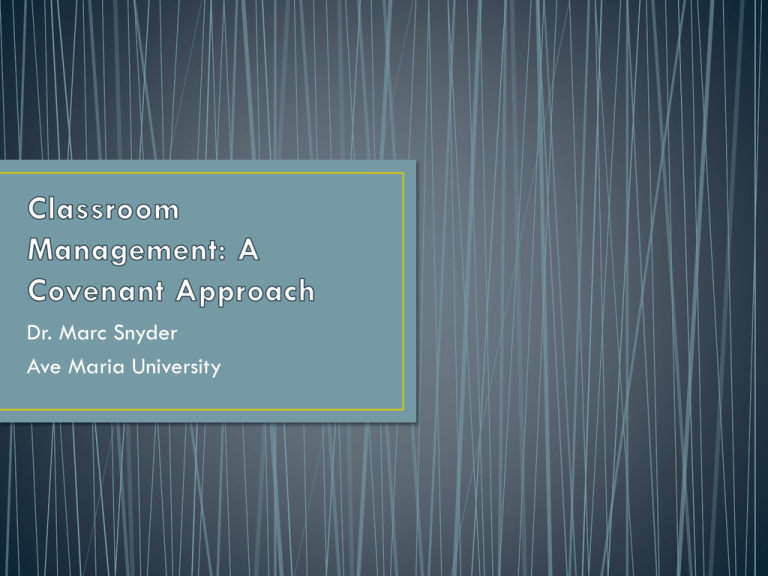
Dr. Marc Snyder Ave Maria University Haim G. Ginott (1922-1973) Between Teacher and Child, 1972 “I touch the future. I teach.” Christa McAuliffe (September 2, 1948 – January 28, 1986 ) “Only the brave should teach. Only those who love the young should teach. Teaching is a vocation. It is as sacred as priesthood; as innate a desire, as inescapable as the genius which compels a great artist. If he has not the concern for humanity, the love of living creatures, the vision of the priest and the artist, he must not teach.” ~ Pearl S. Buck (1892 – 1973) According to Harry Wong “The single greatest effect on student achievement is not race, it is not poverty — it is the effectiveness of the teacher.” ~ “It is the teacher — what the teacher knows and can do — that is the most significant factor in student achievement.” “In an effective classroom students should not only know what they are doing, they should also know why and how.” Which classroom is yours? Which classroom would you rather walk by? • Classroom management – act of managing relationships, behaviors, and instruction for learners • Discipline – the act of teaching students how to behave appropriately; not just punishment Covenant/Conduct/Content Management Interplay Covenant Management Content Management Conduct Management • 1) Definition of covenant management • 2) Covenant management with the classroom group • 3) Covenant management with the individual student • 4) Covenant management and the research • According to Iverson (2003), a covenant is a promise, a binding agreement between two or more persons • Covenant management is the facilitation of trusting, respectful relationships, willingly entered into, that promote optimal success for all children Covenanting with the Classroom Group • Human relationships are complex and require constant attention and nourishment • Classrooms are especially complex environments in which to build quality relationships • Teacher and student are usually “stuck” with each other and are expected to get along • Creating a working unit from an assortment of student personalities is a difficult task • A classroom group takes on the personality of its members, some of whom will have a more compelling impact on the group than others • The power aspects of the “hidden” curriculum can shape much of classroom life • E.g., a few students with strong personalities can turn others against one or two students (bullying) • It is the teacher’s responsibility to form healthy peer relationships in the classroom through the year • The forming stage can be characterized as the “honeymoon” period • This is the stage when students are generally on their best behavior • Students look to the teacher for structure and direction • This is an important time for teachers to treat all class members equally • Virtually all the research points to the beginning of the school year as the linchpin for effective classroom management • Four seminal studies on the beginning of the school year performed (two at elementary and two at secondary): • The results showed that the most effective teachers made sure classroom management strategies: 1) were understood by students, 2) accepted by students, and 3) practiced until they became routine • The frequently used expression “you have only one chance to make a first impression” applies well to the first day of class • What you do on the first day of school sets the tone that can carry you through the rest of the year • Do the following: 1) stand near door, 2) greet students, 3) make seating chart, 4) tell something about yourself and do brief get-acquainted activity, and 5) discuss class rules and procedures • Go over rules and accompanying consequences; explain their rationale and invite input from students; make any changes if necessary • Practice classroom procedures with students until they can be executed efficiently and without confusion • Go over grading procedures with students; again, invite input from students • Continue to engage in activities that allow students to get to know you and one another better • The storming stage can be characterized by the testing of limits; students become relaxed and are willing to take a few risks • Often occurs between October and December • Teacher should not get upset, but see this stage as an opportunity to restructure and renegotiate relationships; expectations need to be clarified • Teacher must pay more attention to conduct management • Some distancing from the teacher; students will expect teacher to be fair when managing individual and group behavior • Teacher must establish clear limits by the end of this stage • The norming stage, which often extends after Christmas break for several months, is dominated by orienting and fueling activities • Students have (hopefully) accepted standards of conduct and can orient themselves to real learning • Fueling activities can keep students moving towards their learning (and social) goals • For teachers, the norming stage is the stage in which the relationship between the teacher and student is grounded (hopefully) in mutual respect • The performing stage is the coalescence of the three previous stages • Students are now more self-reliant, self-controlled, and selfdisciplined than at the beginning of the year • Capable of working independently and in groups • Occurs within the other three stages and reaches its zenith in the final months of the school year • The extent to which the performing stage is distributed throughout the school year depends on the management abilities of the teacher Covenanting with the Individual Student • When students are asked to account for their motive for learning, they frequently cite their admiration and respect for a particular teacher • According to Glasser (1972), today’s society is role oriented (identity) rather than goal oriented • In a role-oriented society, people place more value on being respected as human beings than on being valued for what they can do • In other words, the student in the classroom is saying, “I can insist that I have a right to respect and dignity apart from what I can do” • Respecting students for who they are is an essential first step in building positive relationships • Teachers recognize that a renewed focus on relationship building can help resolve difficulties with individual students • Emphasis on getting assignments turned in should be set aside in favor of building the trust and confidence of the student • What a student needs most is often the reaffirmation as a person; this allows the student to open up to the teacher • What happens if relationship effort attempts fail and a student persists in disrupting the class? • The teacher cannot dismiss the behavior • The teacher must engage in a problem-solving process to help the student select more responsible behavior • Glasser (1965; 1977) developed an eight-step problemsolving process to help students regain control Glasser’s Eight-Step Problem Solving Process 1) Get Involved with the Student 2) Deal with the Student’s Present Behavior 3) Get the Students to Make Value Judgment About the Behavior 4) Help the Student to Develop a Plan to Change the Behavior 5) Get a Commitment from the Student to Stick to the Plan 6) Do Not Accept Excuses for a Failed Plan 7) Do Not Punish or Criticize the Student for Broken Plan 8) Never Give Up – Return to Step 3 and Start Again • The research on the impact of teaching students strategies geared towards personal responsibility is strong • According to Marzano (2003), responsibility strategies are associated with a 25% decrease in disruptive behaviors • Self-monitoring and control techniques • Cognitively based strategies • The following class meetings offer students an opportunity to entertain issues and think about problems that defy singular and simple answers: • 1) Social Problem-Solving Meetings • 2) Open-Ended Meetings • 3) Educational-Diagnostic Meetings Covenant Management and the Research • In a study involving 68 high school students, 84% said that disciplinary problems that occurred could have been avoided by better teacher-student relationships • In their review of the literature, Sheets and Gay (1996) note that many behavioral problems ultimately boil down to a breakdown in teacher-student relationships • “The causes of many classroom behaviors labeled and punished as rule infractions are, in fact, problems of students and teachers relating to each other” • Barr (1958) & Good & Brophy (1995) identify the following characteristics that make teachers likeable: consideration, flexibility, patience, (friendly, helpful, empathetic, understanding, good listeners) • In terms of teacher-student dynamic, Wubbels et al. (1999) identify two dimensions whose interactions define the relationship between teacher and students: • Dominance vs. submission and cooperation vs. opposition • High dominance = clarity of purpose of guidance (but also lack of concern for interests of students); high submission = lack of clarity and purpose (middle ground = optimum) • High cooperation = concern for the needs and opinions of others (but also inability to stand on one’s own); high opposition = active antagonism towards others (middle ground = optimum) High Dominance Optimal Teacher-Student Relationship High Opposition High Cooperation High Submission • Chiu and Tulley (1997) conducted a study on student preferences for the following teacher management styles: • 1) Rules/rewards-punishments = teachers articulate rules and procedures and present them to students (students who follow rules = rewards; do not follow rules = consequences) • 2) Relationship-listening style = little or no emphasis on disciplinary issues per se; emphasis is on attending to student concerns • 3) Confronting-contracting style = direct attention to disciplinary problems, but not in an inflexible way • 4) No preferred approach • Out of 712 students in grades 4, 5, and 6 interviewed (368 males and 344 female), results indicate a clear preference for: • Confront/contract (420 student or 59%) • Listening (135 students or 19%) • Rules/Rewards – Punishment (121 students or 17%) • No preference (36 students or 5%) • Schools may be the only place where the needs of “problem” students are met • Some problems students face include: homelessness, depression, suicide, violent students, eating disorders, alcoholism, ADHD, physical and sexual abuse, etc. • In a study conducted by Brophy, 98 teachers were interviewed and presented with vignettes regarding “problem” students • Results indicated that effective teachers employ different behavioral strategies with different students • Talking informally with students before, during, and after class about their interests • Greeting students outside of school – for instance, at extracurricular events or at stores • Singling out a few students each day in the lunchroom and talking to them • Being aware of and commenting on important events in students’ lives, such as participation in sports, drama, or other extracurricular activities • Complimenting students on important achievements in and outside of school • Meeting students at the door as they come in and saying hello to each child, making sure to use his or her fist name • Emphasize what was right (giving credit to the aspects of the incorrect response that are correct) • Encourage collaboration (allowing students time to seek help from peers) • Restate the question (allow time for students to think before you expect a response) • Rephrase the question (paraphrase the question) • Give hints or clues (provide enough guidance so that students can gradually come up with the right answer) • Respect the students right to pass, when appropriate • Covenant management is an important aspect of classroom management that is often overlooked • It can be defined as the facilitation of trusting, respectful relationships, willingly entered into, that promote optimal success for all children • Covenant management can be viewed from the microsystem level: classroom group and individual students • Review of the literature emphasizes that the majority of discipline problems are the result of poor teacher-student relationships
